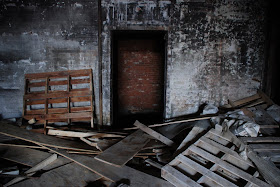 May 27, 2010 -
May 27, 2010 -Every day, the students of Juan Morel Campos Secondary School walk by this abandoned building in Williamsburg, Brooklyn. Few have ever really noticed it. One or two students may have snuck a quick peek into the burnt-out ground floor, but most of the students, when asked, imagine the building is filled with rats. And dead bodies. And ghosts.
The true story of this abandoned building is even more colorful. In the early 1980's, it housed a Jewish synagogue on the ground floor and artist studios on the upper floors. "The rabbi was the landlord," said Ron Rocco, an artist who first leased a studio space in the building in 1984. Rocco recalled seeing huge matzo ovens in the back of the building and, in the basement below the synagogue, handmade mikvehs - the ritual baths used to purify members of the Hasidic community.
This all came to an end in 1989, a second artist from the building recalled, with a "dramatic arson story... a typical case of 'Catskills Lightning'." Ron Rocco was there on the day of the fire - "It was like 9:30 in the morning and all of the sudden I see this big black billowing smoke coming up from the the floorboards... nobody died or was injured but there was huge amounts of structural damage. I had a 20 foot by 10 foot hole in my floor in two spaces. All my walls were collapsed." The synagogue on the ground floor was destroyed, and never again reopened.
What followed was even more painful. "We weren't going to leave unless we absolutely had to leave, so we rebuilt by ourselves," recalls Rocco. It took about 5 years to repair the studio spaces, and throughout the 1990's, artists worked in the building and exhibited at a Rocco's in-house gallery space, Bernadette Salvage Fine Art. But, according to one artist, "the ownership of the building was in dispute since [the fire], and though artists living in it sought to gain control, eventually they lost the many court battles, under some nasty circumstances." Even as Williamsburg was becoming a hotspot for artists from around the country, the residents of this building were struggling to cope with the costs of 13 years of litigation.
Rocco and his fellow artists were forced to leave the building in 2003. "There is so much history in this place, there is so much violence in the process of what happened to this building, and to us in this building," Rocco recalled. "And then finally to then get pushed out... just left a very bitter bitter edge to the whole thing." To say goodbye, two other artists in the building remember organizing "a big 27-artist and multiple-band show/party for the eviction, called Everything Must Go."
The building has remained empty and abandoned since 2003. On the ground floor, all that remains of the synagogue is a large safe that may have once housed the Torah. A cat skeleton lies nearby on a dirt covered floor. On the upper floors, a squatter has created a home. A homemade bed, covered in a layer of undisturbed dust, has a baseball bat laid across it. Nearby are glass bongs, a knife, unused needles, empty 40s. On the floor are dozens of 35mm slides and a magazine about homeless photography, implying the squatter may have also been an artist. From one corner, a giant skull lamp looks out. In a closet, two dead pigeons are strung up.
To Ron Rocco, who spent almost 20 years here, this building tells a story "about real estate and the arts in New York.... Its a dirty story and art is supposed to be pristine... but the fact of the matter is that it has been dovetailed and undermined by the real estate presence in this town, because its the first wedge that brings in gentrification. The artists themselves don't have anything to gain from it - they just become pawns in the game."
---
These photographs were commissioned by the BRIC Rotunda Gallery and were exhibited at the gallery in an installation titled This Building Has A Story. Organized by artist Angela Earley, this installation included artwork by the students of Juan Morel Campos Secondary School, who were inspired by my photographs. This Building Has A Story was included in the 22nd Annual BRIC Contemporary Art Education Exhibition, titled Invent/Onsite, and curated by Hawley Hussey, BRIC's Director of Education. Invent/Onsite was on view at the BRIC Rotunda Gallery in May and June, 2010.














